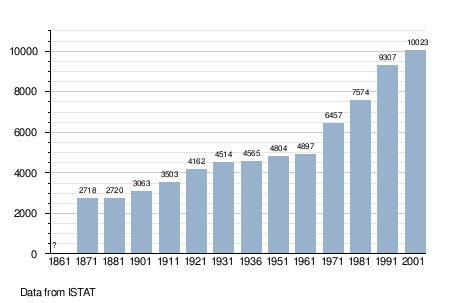Virgilio, Lombardy
| Virgilio | |
|---|---|
| Comune | |
| Comune di Virgilio | |
 Virgilio | |
| Coordinates: 45°7′N 10°47′E / 45.117°N 10.783°ECoordinates: 45°7′N 10°47′E / 45.117°N 10.783°E | |
| Country | Italy |
| Region | Lombardy |
| Province | Province of Mantua (MN) |
| Frazioni | Cerese, Cappelletta, Pietole |
| Area | |
| • Total | 31.3 km2 (12.1 sq mi) |
| Population (Dec. 2004) | |
| • Total | 10,524 |
| • Density | 340/km2 (870/sq mi) |
| Time zone | CET (UTC+1) |
| • Summer (DST) | CEST (UTC+2) |
| Postal code | 46030 |
| Dialing code | 0376 |
Virgilio is a comune (municipality) in the Province of Mantua in the Italian region Lombardy, located about 130 km southeast of Milan and about 6 km south of Mantua. As of 31 December 2004, it had a population of 10,524 and an area of 31.3 km².[1]
The municipality of Virgilio contains the frazioni (subdivisions, mainly villages and hamlets) of Cerese, Cappelletta, and Pietole.
Virgilio borders the following municipalities: Bagnolo San Vito, Borgoforte, Curtatone, Mantua.
According to legend, the village of Andes (Pietole Vecchia), a short distance from the center of Pietole in modern Virgilio, is the birthplace of the Roman poet Publius Vergilius Maro, known in English sources as Virgil or Vergil (70 BCE – 19 BCE). Virgil is renowned for his three major works: the Eclogues (or Bucolics), the Georgics, and the Aeneid.
The comune di Virgilio is cited as "Pietoli patria di Virgilio" in the Gallery of Maps located in the Vatican Museums and painted by Iganzio Danti This remarkable project, begun in early 1580 and completed about 18 months later, maps the entirety of the Italian peninsula in 40 large-scale frescoes, each depicting a region as well as a perspective view of its most prominent city.
Demographic evolution

References
- ↑ All demographics and other statistics: Istituto Nazionale di Statistica (Istat).